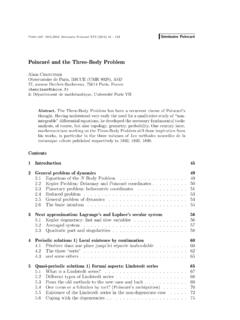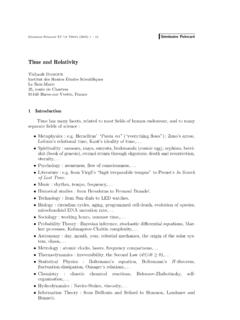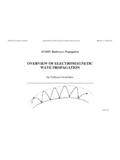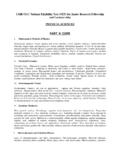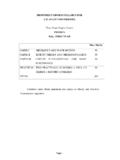Transcription of The Genesis of the Theory of Relativity
1 S eminairePoincar e 1 (2005)1 { 22S eminairePoincar eTheGenesisof theTheoryof RelativityOlivierDarrigolCNRS: Rehseis83,rueBroca75013 ParisThemostfamousof AlbertEinstein'spapersof 1905is undoubtedlytheoneconcerningthetheoryof Relativity . Any modernphysicistknowsthatthistheoryimpose sa strictandgeneralconstraint onthelawsof curiouslaymanwondersat thedaringreformof ourancestralconceptsof ,thetheoryofrelativity gave riseto rstof thismythis thatEinsteindiscoveredthetheoryof Relativity in a singlestrokeof geniusthatde esany Einstein'sreminiscencesfavor thisthesis,forinstancehisallusionto a conversationwithMicheleBessoin which he wouldhave suddenlyrealizedthata reformof theconceptof timesolved longstandingparadoxesof a deepinnovationis by de nitionimpossible,sincearadicallynewideac annotbe thecaseof Einstein'srelativity therarity of pre-1905sourcesfurtherdiscourageshistori calreconstruction.}
2 Andinvitesus to leave thismomentousdiscoveryin itsshroudof notappealto teachersof orderto convey somesortof logicalnecessity torelativity Theory , theyhave constructedanothermythfollowingwhich afewexperiments drove ,thefailureof ether-driftexperiments ledto therelativity principle;andtheMichelson-Morleyexperime nt ledto theconstancyof thevelocity of light; Einsteinonlyhadtocombinethesetwo principlestoderiverelativity counterpoiseto thismyth,thereis a third,idealistaccount in which Einsteinis supposedto have reachedhistheoryby a philosophicalcriticismof fundamentalconceptsin thespiritofDavidHumeandErnstMach, withouteven knowingabouttheMichelson-Morleyexperimen t, andwithoutworryingmuch aboutthetechnicalitiesof contemporaryphysicsin conscientioushistoriancannottrustsuch myths,even thoughtheymay containa hisconclusionsby reestablishingthecontextsin which Einsteinconductedhisre ections,by takingintoaccount hiseducationandformation,by introducingtheseveralactorswhosharedhisi nterests,by identifyingthedi cultiestheyencounteredandthestepstheytoo kto solve thisprocess.
3 Hemustavoidthespeculative llingof gapsin rigidifyingany ill-foundedinterpretation,heshouldo eranopenspectrumofinterpretive hope to show in thispaper,thissober method allowsa fairintelligenceof theoriginsof rstindicationof theprimarycontextof theearlytheoryof Relativity is foundin theverytitleof Einstein'sfoundingpaper:\Ontheelectrodyn amicsof movingbodies."Thistitlechoicemay seembizarreto themodernreader,whode nesrelativity theoryas a theoryof withthelatterview,the rstsectionof Einstein'spaper dealswitha newkinematicsmeant to applyto any kindof of thepaper nonethelessdealswiththeapplicationof thiskinematicsto theelectrodynamicsandopticsof , Einsteinwantedto solve di cultieshe hadencounteredin thisdomainof surveyof physicsliteraturein theyears1895-1905showsthattheelectrodyna micsof movingbodiesthenwas a Einstein'spaper,severalstudieswithsimila rtitlesappearedin experimentalandtheoreticalworkwas beingdonein , o eredmutuallyincompatiblesolutions.
4 EminairePoincar esometimesdiagnoseda seriouscrisisin thisdomainof Hertz'sexperiments of 1887-8ontheelectricproductionof electromagneticwaves,Maxwell's eldtheorywas thenaturalframefordiscussingboththeelect rodynamicsandtheopticsof orderto understandtheevolutionof thissubject,onemust rstrealizethatthetheorythatMaxwello eredin histreatiseof 1873widelydi eredfromwhatisnow meant by \Maxwell'stheory."1 Maxwell'stheoryas it wasLike mostof hiscontemporaries,Maxwell regardedtheexistenceof theetheras a fundamentalandundeniablefactof electromagneticactions,which includedopticalphenomenain a phenomenologicaltheoryconcernedwiththema croscopicstatesof a continuousmedium,theether,which couldcombinewithmatterandshareitsvelocit yv. Thesestateswerede nedby fourvectorsE,D,H,Bthatobeyeda fewgeneralpartialdi erentialequationsaswellassomerelationsde pendingontheintrinsicpropertiesof themostcompleteandconciseformlatergivenb y OliverHeavisideandHeinrich Hertz,thefundamentalequationsreadr E= DB=Dt ;r H=j+DD=Dtr D= ;r B= 0;(1)wherejis theconductioncurrent andD=Dtis theconvective derivative de nedbyD=Dt=@=@ r (v ) +v(r ):(2)In a linearmedium,the\forces"EandHwererelated to the\polarizations"DandBby therelationsD= EandB= H, andtheenergydensity (1=2)( E2+ H2) of themediumhadtheformof anelasticenergy.
5 For Maxwellandhisfollowers,thechargedensity andtheconductioncurrentjwerenotprimitive concepts:theformercorrespondedto thelongitudinalgradient of thepolarizationor \displacement"D, andthelatterto thedissipative relaxationof thispolarizationin a thedisplacement constitutedanotherformofcurrent. FollowingMichaelFaraday, Maxwell andhisdisciplesregardedtheelectric uidsof earliertheoriesas a na velysubstantialistnotion1 Theappearanceof theconvective derivativeD=Dtin Maxwell'stheoryderives fromhisun-derstandingof thepolarizationsDandBas statesof a singlemediummadeof etherandmatterandmovingwitha well-de nedvelocityv(thatmay varyfromplaceto place):thetimederivativesin thefundamentalequationsmustbe taken alongthetrajectoryof a given particleof of electromagneticinduction,r E= DB=Dt= @B=@t+r (v B).
6 (3)containsthe(v B) contributionto theelectric eldin theorem,it leadsto theexpressionIE dl= ddtZ ZB dS(4)of Faraday'slaw of induction,whereintheintegrationsurfacemo ves eldis causedby a magnet,themagnetic uxonlydependsontherelative positionof themagnetandthecircuitso thattheinducedcurrent onlydependsontheirrelative sum,theconceptualbasisof Maxwell'soriginaltheorywidelydi eredfromwhattoday' andmagnetismwere eld-derivedconcept, ,A treatiseonelectricityandmagnetism, 2 vols.(Oxford,1973); ,\ Uber dieGrund-gleichungenderElektrodynamikf ur bewegteK orper,"AnnalenderPhysik, 41 (1890), , 2005 TheGenesisof theTheoryof Relativity3electromagnetismtreatsthemas quasi-materialetherwas (1)onlycorrespondto our\Maxwell equations"in thecaseof bodiesat rest,forwhich thevelocityvis zeroandtheconvective derivativeD=Dtreducesto thepartialderiva-tive@ Onethinghasnotchanged,however:thetheory' sability to a homogenousinsulatorat rest,Maxwell'sequationsimplytheexistence of transversewaves propagatingat thevelocityc= 1=p.
7 Havingfoundthiselectromagneticconstant to beverycloseto thevelocity of light, Maxwellidenti edthesewaves withlight ,elastic-solidtheoriesof fewyearsafterMaxwell'sdeath(in1879),a growingnumber of Britishphysicistssalutedthisachievement andcameto regardMaxwell'stheoryas philosophicallyandpracticallysuperiorto electricity andmagnetism,basedonelectricandmagnetic uids(orAmpereancurrents)directlyactingat a 'stheoryuntil in 1888 Heinrich Hertzdemonstratedtheemissionof electromagneticwaves by a rmed,agrowingnumber of physicistsadoptedMaxwell'stheoryin a moreor lessmodi thistheorywas notwithoutdi hadhimselfnotedthathisphenomeno-logicala pproach ledto wrongpredictionswhenappliedto opticaldispersion,to magneto-optics,andto theopticsof thesecaseshesuspectedthatthemolecularstr uctureofmatterhadto be taken into : Theopticsof movingbodiesMaxwell'sideaof a singlemediummadeof etherandmatterimpliedthattheetherwasfull ydraggedby movingmatter, movingcircuitsandmagnets,it was problematicin therealmof rstdi culty concernedtheaberrationof stars,discoveredby theBritishastronomerJamesBradleyin 1728.
8 Thedirectionof observationof a xedstarappearsto varyperiodicallyin thecourseof ayear,by anamount of thesameorderas theratio(10 4) of theorbitalvelocity of theearthto thevelocity of light simplyexplainedthise ectby thefactthattheapparentvelocity of a light particleis thevectorsumof itstruevelocity andthevelocity of theearth( ).In theearlynineteenth century, thefoundersof thewave theoryof light ThomasYoungandAugustinFresnelsavedthisex planationby assumingthattheetherwas completelyundisturbedby themotionof theearththroughit. Indeed,rectilinearpropagationat constant velocity is allthatis 'sassumptionimpliedanetherwindof theorderof 30km/sontheearth'ssurface,fromwhich a minutemodi cationof thelawsof opticalrefractionought to follow.
9 AsFresnelknew,anearlierexperiment of hisfriendFran coisAragohadshownthatrefractionby a prismwas infactuna ectedby theearth' notAragohadreachedthenecessaryprecisiono f 10 4, Fresneltookthisresultseriouslyandaccount edforit by meansof a partialdraggingof explainedas Fermat'sprinciple,thetrajectorythatlight takes totravelbetweentwo xedpoints (withrespecttotheearth)is thatforwhich thetravelingtimeis aminimum,whetherthemediumof propagationis at restor of light withrespectto theetherin a substanceof opticalindexnisc=n, ifcdenotesthevelocity of light. Theabsolutevelocity of theetheracrossthissubstanceis u, where is thedraggingcoe cient anduis theabsolutevelocity of thesubstance(theabsolutevelocity beingthatwithrespectto theremote,undisturbed partsof theether).
10 Therefore,thevelocity of light alongtheelementdlof an arbitrary2J. Bradley, \Anewapparent motiondiscoveredin the xedstars;itscauseassigned;thevelocity andequablemotionof light deduced,"Royal Society of London,Proceedings, 35 (1728), ,\Lettred'AugustinFresnel a Fran coisAragosurl'in uencedumouvement terrestredansquelquesph enom enesd'optique,"Annalesde chimieet de physique, 9(1818),alsoinOeuvres compl etes, Paris(1868), , eminairePoincar eFigure 1 a xed starin theskyis judged by theorientationof a narrowstraighttube throughwhichit canbe theearthis movingwithrespect to the xed starsat thevelocityu, thelattersweepsthedistanceu duringthetime thatthelightfromthestartakesto travelfromthebeginningto theendof thetube. Therefore, thetruelightpathmakesa small anglewiththedirectionof thetube.


